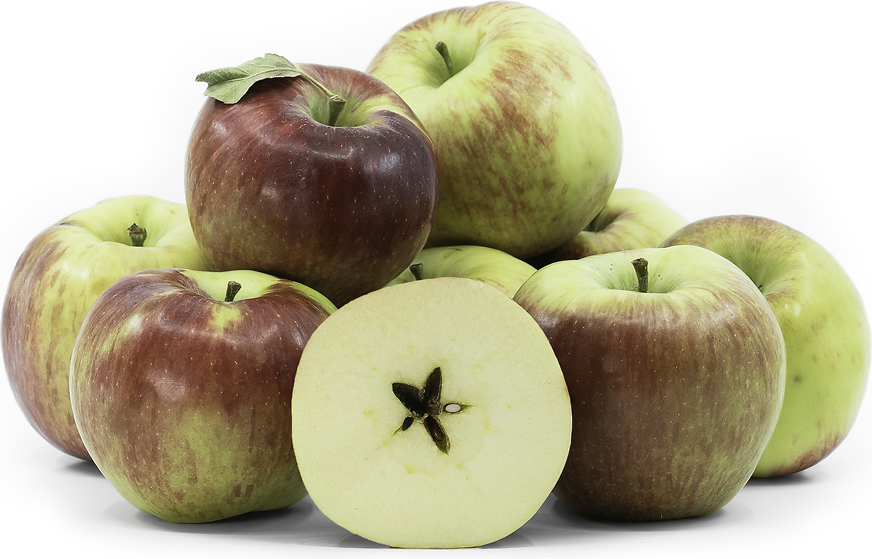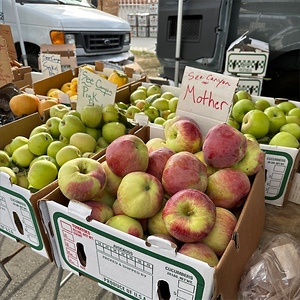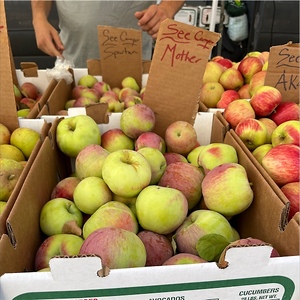


Mother Apples
Estimated Inventory, lb : 0
Description/Taste
Mother apples are a medium to large varietal with a generally conical to ovate shape. The apples sometimes display an irregular appearance with sloping shoulders and slanted bases, and they showcase light ribbing with textured brown russet surrounding the stem. The thin skin has a yellow-green base hue and is covered in bright red blush, striping, and striations. The surface also has a satiny, slightly greasy feel, is delicate, bruising easily, and features a few brown lenticels with tiny russet dots. Underneath the surface, the cream-colored to ivory flesh is aqueous, moderately coarse, and tender with a crisp but soft consistency. The flesh also contains a central core filled with tiny dark brown seeds. Mother apples are aromatic and emit a rich fragrance said to be reminiscent of balsamic. The flesh also carries a distinctly sweet, floral, and spice-filled flavor with honeyed, nutty nuances and subtle vanilla, pear, and melon notes.
Seasons/Availability
Mother apples are available in the fall through early winter.
Current Facts
Mother apples, botanically classified as Malus domestica, are an American heirloom variety belonging to the Rosaceae family. The mid-season apples were discovered in the early 1800s in Massachusetts and were selected as a home garden variety for their complex flavoring. Mother apples are also known as American Mother, Queen Anne, Mother of America, Gardner’s apple, and Bolton Mother apples. The variety never achieved commercial success as it produced variable crops each year, but the unusual apples were introduced to England, where they became a popular apple in private orchards throughout the early 20th century. Mother apples are primarily a dessert cultivar valued for their rich, aromatic, and spice-filled taste, but the apples are also used on a smaller scale for baked goods such as pies. In the modern-day, Mother apples are a rare variety found in remaining heritage orchards throughout England and the Eastern United States.
Nutritional Value
Mother apples are a good source of vitamins, including vitamin A to maintain healthy organ functioning, vitamin C to strengthen the immune system, vitamin E to protect the cells against free radical damage, and vitamin K to assist in faster wound healing. The apples also provide fiber to regulate the digestive tract, potassium to balance fluid levels within the body, and other amounts of nutrients such as boron, zinc, iron, magnesium, copper, and calcium.
Applications
Mother apples have a complex flavoring often compared to a blend of fruity, floral, and spice-filled nuances. The soft and crisp apples are mainly consumed straight, out of hand, and are enjoyed with soft cheeses, nuts, and other fruits as an appetizer or afternoon snack. Mother apples can also be tossed into salads, mixed into fruit and grain bowls, layered into sandwiches, or sliced and placed on nut butter toast. The apple’s unique flavoring can be used as a base layer in ciders, or the juice can be mixed into other hot beverages as a seasonal drink. In addition to fresh preparations, Mother apples are viewed as a dual-purpose variety and are often baked into muffins, pies, tarts, bread, crisps, cobblers, and scones. The soft nature of the apples also lends itself well to sauces for roasted meats, purees for desserts, or sprinkled with spices as a standalone apple sauce side dish. Mother apples pair well with nuts such as pecans, walnuts, almonds, and pistachios, vanilla, browned butter, spices including cinnamon, nutmeg, cloves, and ginger, herbs such as parsley, rosemary, sage, and mint, and cheeses including cheddar, brie, camembert, or goat. Whole, unwashed Mother apples have a short shelf life and will only keep for a couple of weeks when stored in the refrigerator’s crisper drawer.
Ethnic/Cultural Info
Mother apples were the only American apple variety that made the list of Mr. J.M.S. Potter’s five favorite apples. Mr. Potter was a former director of the National Fruit Collection in England, one of the world's largest collections of apple varieties. The National Fruit Collection was established in the early 1800s in Chiswick, London, in an effort to record and preserve apple cultivars grown in the United Kingdom. In 1831, a catalog of the collection was published by the Royal Horticultural Society, and the collection encompassed over 1,400 apple varieties. Mr. Potter joined in the preservation of the collection sometime in the mid-20th century and held a leadership position under 1972. During this time, Mr. Potter continued to expand the collection, leading it to eventually have over 2,000 different varieties of apples. Of the thousands of apples within the collection, Mr. Potter recorded his top five, including the American Mother apples and four British types, comprised of ashmead’s kernel, ribston pippin, cox’s orange pippin, and st. edmund’s pippin. Mother apples can still be found in the National Fruit Collection and the Heritage Orchard at Brogdale Farm near Faversham, Kent, in England.
Geography/History
Mother apples were developed by apple enthusiast Steven Partridge Gardner in 1844 in Bolton, Massachusetts. Gardner was a former militia general who ran a store behind his house that stocked spirits and sundry items. Gardner also had a passion for apple cultivation and experimented with crossing new varieties in his home garden. The parentage of Mother apples is unknown, but after their discovery in the early 19th century, the variety was introduced to England by famous nurseryman Thomas Rivers under the name American Mother. Throughout the 1920s and 1930s, Mother apples were a favored apple variety for private orchards in England, selected for their distinct, sometimes fickle flavor. The apples were also grown in gardens in the United States, but they almost disappeared entirely in the 1920s. In 1993, Mother apples received the Award of Garden Merit, or AGM, from the Royal Horticultural Society. Today Mother apples are an heirloom variety cultivated through a few specialty farms and found in heritage orchards in the United States and England. The variety is also grown in home gardens. In England, the Worcester Horticultural Society sells wood for grating for home garden planting.
Recipe Ideas
Recipes that include Mother Apples. One
| Your Homebased Mom |
|
Autumn Apple Salad |
| The Prairie Homestead |
|
Apple Cider Vinegar from Scraps |
| The Seasoned Mom |
|
Light and creamy Apple Salad |









